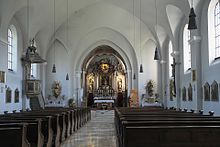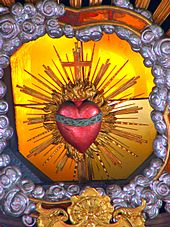St. Michael (Lochhausen)
The Roman Catholic parish church of St. Michael in the Munich district of Lochhausen is an example of extensions in the 20th century that were subject to aspects of monument protection.
location
The parish church (Schussenrieder Straße 6) is located in the center of the old town center.
history
The exact origin of the first church in Lochhausen cannot be precisely determined. The parish register of 1627 mentions a portable altar, the inscription of which reports its consecration by Bishop Adalbert von Freising in 1172. St. Michael becomes documented in 1312 when it is listed as an independent parish with the Freiham branch . The exact year of the parish elevation and thus the separation from the mother and original parish , which must have occurred before 1315, is not known. However, it can be assumed that a church existed.
The late Gothic building, which is still recognizable as such in the choir and saddle tower, cannot be precisely dated. There is evidence of the purchase of a bell in 1430 and the renovation work in 1449, which are related to the elimination of the consequences of the war caused by the Battle of Alling in 1422.
In 1590 the tower was given an iron "clock" with gold-plated hands. Another renovation took place in 1607–1609; the choir altar and the two portable side altars were particularly affected; According to a list from 1727, these were presumably consecrated and donated to the Blessed Virgin Mary and Saint Anna. Another renovation took place in 1626, which was probably limited to the tower, because the repair of the tower clock and the consecration of a new bell are known in the same year.
The sacristy was built in 1708, and five years later an oratory was set up to furnish the church with seats, cut out a new window and the others with transparent glass. In 1735, an inheritance forced the pastor, who complained about lack of space at the high feasts, to expand the nave by "8 shoes", to draw in a wooden vault and to separate the two side altars so that the entrance to the choir would be extended a little. 1740-1745 the church was baroque .
After the nave became too small, the parish decided to build a new building based on a design by Franz Xaver Boemmel . In 1926/27 the old nave was demolished and replaced by a new building. At the same time, the remaining choir apse was renovated. The nave was built in the neo-baroque style with echoes of the Upper Bavarian brick Gothic, so that the new building as such is not noticeable to the art-historical layman and merges with the late Gothic choir and saddle tower to form a unit. St. Michael is thus an example of the gentle new building, following the principles of monument protection at the time, which was inaugurated on September 11, 1927 by Michael Cardinal von Faulhaber .
After the Second World War , St. Michael was renovated in 1965/66. As part of the purification of the nave, the two side altars were removed and the church was redesigned in accordance with the new liturgical statutes of the Second Vatican Council ; Most noticeable here is the erection of a people's altar below the choir arch. At the same time, the Munich church painters Karl Eixenberger and T. Anton Petri uncovered and added to the original version of the choir stucco and the high altar.
1980–1986 St. Michael was subjected to a further general renovation. The choir apse and the saddle tower were completely renovated and the foundation on the north side was underpinned with a 1.25 m thick concrete wall. Inside the bottom were designed with Solnhofener plates Pews stained created three new and renovated altar all painting. The pictures of the apostles and a glass painting that were removed during the purification in 1965/66 were returned to the church. All other statues have been repainted, the church windows have been restored with hexagonal leaded Goethe glass . In 1985 the parish refurbished the sacristy .
Peal
The ringing, which consists of the four bells St. Michael Bell , Sacred Heart Bell , Ave Maria Bell and St. Margaret Bell , comes from the foundry of the Bochum Association and was consecrated in 1950 by Auxiliary Bishop Johannes Neuhäusler .
organ
Today's Hans Karl organ dates from 1976.
Significant works
- Lochhausen Madonna (late Gothic)
- St. Michael (statue in the high altar, around 1740/45)
- Lead glass window St. Michael (signature: "J Baumeister")
Others
Bishop Johann Theodor von Freising confirmed the establishment of a brotherhood of the Sacred Heart of Jesus in 1737. This brotherhood existed until the 20th century. Much of the baroque transformation from 1740–1745, especially that of the choir apse, was made possible by donations from the Sacred Heart Brotherhood.
literature
- Schnell, Hugo / Steiner, Johannes: Schnell, Art Guide No. 1694, 1st edition 1988
Web links
Individual evidence
- ↑ Megele: Building history atlas of the state capital Munich - Westl. Suburbs of the city. Stadtarchiv, München 1956 p. 41 Catholic Church, draft, Franz Xaver Boemmel, inauguration on September 11, 1927, in; Karl Sattler; Langwied in the past and now, Munich 1931.
Coordinates: 48 ° 10 ′ 47.4 " N , 11 ° 24 ′ 22" E


